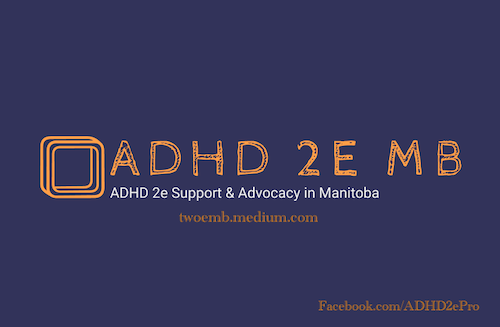Originally posted on Medium.
Have you noticed a change in my posts over the past year? OK, with everything going on, it not surprising that pretty much everyone’s posts have changed, so you may not have noticed.

A Tale of Two Career Streams
If you’re seeing posts from me both from Pawsitive Pet Care and from ADHD 2e MB and are wondering which am I doing? The answer is both. I’m doing both. Of course I am. Because I love both and right now I can do both.
If you’re interested in the background story, here it is. If you’re not… well, perhaps one of our other blogs will be of interest, depending on which page you follow:
Long story…. a little less long:
In 2006 I graduated (with Honours) from Humber College in Toronto, after completing a 3-year full-time intensive Child and Youth Work program and received my CYW diploma. I worked in a group home in Ontario for one year until we moved to Winnipeg in 2007, where I started my second degree, Psychology, with majors in both Child Psychology and Animal Learning (this will not surprise anyone who knows me).
While I was graduating in 2009 I had some health problems (all good now though!). Instead of heading into a full-time career in social services, I had to slow down and focus on taking care of my health at that time. I took a part-time job in a retail pet store because I love animals and because the store was close to home.
Retail Reality
I had forgotten what it was like to work in retail. For one thing, managers expect you to put your personal life on hold for a minimum-wage job. I love soccer and at that time was on a highly competitive soccer team that practiced three times per week, plus had one or two games on the weekends. When I had interviewed the manager said she was willing to work around my soccer schedule, yet when I asked them to do so they gave me a hard time about it.
The other difficulty I encountered was colleagues (even some managers) giving bad pet-care and health-related advice. ProTip: If you are working in a pet food and supplies store, you are not qualified to give dietary and health advice to pet owners. You can recommend products, share what you know about the different brands, and help customers find what they are looking for. You should not be practicing outside of your scope. Giving the wrong advice can be unsafe for pets, so please leave that to the professionals.

There’s got to be a better way!
With those challenges in mind, in May 2010 I started to offer dog-walking and pet-sitting services to families in my neighbourhood. It was small and simple at first, a free ad on Kijiji and a couple of flyers posted at the local park, but within three months it turned into a full-time gig. I loved it (and still do)! In 2012 I was ecstatic when I became pregnant with our son. As I neared closer to my due date I hired someone to cover for my maternity leave. Walking large dogs while very pregnant is challenging, to say the least! With that began the expansion of Pawsitive Pet Care into a bonafide company. We registered with the province, purchased insurance, and I officially became a sole proprietor.
When I returned to work in Fall 2013 things continued growing and it was very satisfying to see our hard work pay off. We hired more staff and our client base grew. In 2017 we moved out of Winnipeg to just West of the city, in the R.M. of Cartier on a beautiful rural property. For about three years our growth continued.
In 2019 my son had a terrible experience at his former school. Like me, he is intellectually gifted and also has ADHD. Being gifted plus having a disability is called “Twice Exceptional” or 2e, hence the “ADHD 2e” in the name.
Not only were his needs not being met, but he was being treated badly. It was heart-breaking, stressful, and just plain awful. So, I dusted off my old child psychology textbooks and became his biggest advocate. We moved him to a much better school where he is so much happier and is flourishing, thankfully.

Then 2020 came along.
And we all know how that story goes.
In March 2020 the cancellations started pouring in, and like so many small businesses in Manitoba (and around the world), we were seriously impacted by Covid-19. Our clients couldn’t go to work or on vacation, so there was little need for dog-walking and pet-sitting services.
What there was a huge need for, though, were child advocates. Families of students with disabilities and exceptionalities often have to advocate and fight for resources for their children, to have their needs met, and for fair and appropriate access to their education. Add to that the stress and chaos of a pandemic, and these disparities grew worse. It is very hard to follow a student’s education plan when doing remote learning. Families were limited in their ability to access certain supports their children normally received at school, such as Resource, Occupational Therapy, Speech Therapy, Guidance Counselling, and much more. This is all unprecedented. Teachers, school staff, families, and students are all trying to figure this out as we go.
Most school staff are working in highly stressful and potentially unsafe conditions (improper PPE, unable to socially distance, not being made a priority for vaccines, being expected to teach both in person and online, the list goes on).
This is where people with my experience and expertise come in. I spent the past several years advocating for my exceptional child, in particular during the very challenging years while he was at his former school. I learned the Manitoba education system inside and out, gained and strengthened my advocacy skills, and updated my academic knowledge and credentials.
Why Am I Telling You All This?
As I mentioned in the beginning: If you’re seeing me post from both Pawsitive Pet Care and ADHD 2e MB and you’re wondering which am I doing… The answer is both. I’m doing both. Of course I am. Because ADHD. Because I love both and right now I can do both. Because I love my son and he has inspired me and re-ignited my passion for advocacy work. I have a fantastic staff team at Pawsitive Pet Care who help me keep things running smoothly (thank you!). I am also lucky to have a husband and son who love me and support me in all my endeavours, no matter how ambitious (I love a challenge and never like to be bored… ADHD y’all, it can be a gift).
I promise I won’t spam my separate business pages with cross-posts, but I will on very rare occasions share posts that apply to both. I hope you’ll support me by liking and sharing ALL OF THE THINGS, and by referring anyone who you feel would benefit from our services (THANK YOU!).
We’ve been so lucky to have such wonderful and supportive friends, family, and clients these past 11 years (11! Pawsitive Pet Care turns 12 years old this summer!).
Thank you all for your support. Please stay safe and healthy. Stay home when you can, wash your hands, wear a mask, and get vaccinated as soon as you’re eligible. I cannot wait until things can start to return to some semblance of normal. I’ll settle for half-normal. Maybe even a quarter.
Stay well,
Jillian Enright, CYW, BA Psych., CPDT-KA
ADHD 2e MB and Pawsitive Pet Care
























